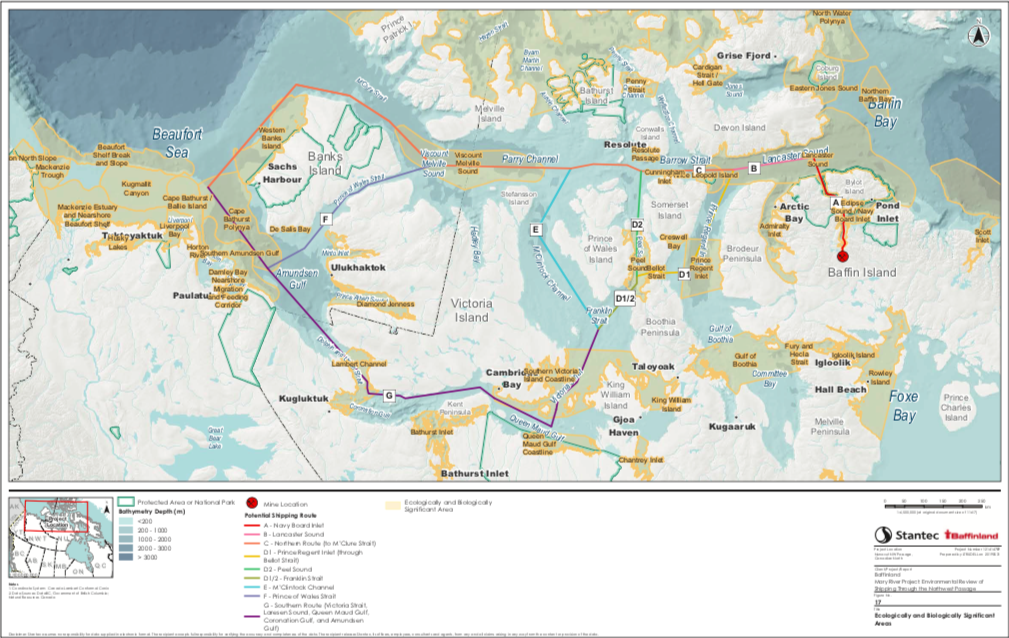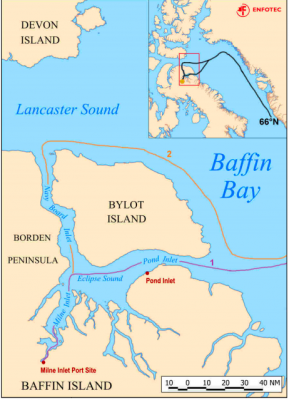Baffinland eyes Northwest Passage as possible shipping route
Consultants’ report states Mary River mine expansion would see some ore shipped west
The Federal Tiber, the first ship to carry commercial ore from Mary River in 2015, lies off Milne Inlet. Baffinland Iron Mines Corp. is looking at alternative routes for its bulk carriers to take Mary River iron to market. (File photo)
Baffinland Iron Mines Corp. is considering shipping ore west from its expanded Mary River mine through the Northwest Passage.
That’s according to a report prepared by Stantec Consulting on behalf of the company.
The report, submitted to the Nunavut Impact Review Board on July 12, states: “In general, the Project is considering transport of some ore west through Navy Board Inlet and into the NWP [Northwest Passage] instead of east through Eclipse Sound and Baffin Bay.”
Any mention of the Northwest Passage during technical meetings held in April and June certainly flew under the radar.
According to an emailed statement sent to Nunatsiaq News from Baffinland on Wednesday, Sept. 4: “The Northwest Passage (NWP) was put forward as an alternative shipping route in the Phase 2 Proposal. During the Technical Review period of the Phase 2 Proposal, Baffinland was asked and committed to providing additional information about alternative marine shipping routes through Navy Board Inlet and the NWP.”
Stantec’s report, an environmental review of shipping through the Northwest Passage, was filed under “commitments” on the Nunavut Impact Review Board’s registry following the technical meetings.
This was in response to comments made during the technical review period by the Department of Fisheries and Oceans and the Government of Nunavut.
The latter specifically asked for estimates of the number of Baffinland ship transits that would use each of the three sea routes, naming, as examples, the Northwest Passage, Northern Sea Route and Transatlantic.
DFO requested specifics on when alternative shipping routes might be used. One route, through Navy Board Inlet, Baffinland responded at the time, could be used to access the Northwest Passage.
Baffinland filed its responses, along with a commitment to both parties, on March 25. It states: “Baffinland is open to discussing the use of Navy Board Inlet as an optional shipping route and is willing to provide a report containing a more complete baseline characterization of environmental conditions, as well as an assessment of potential interactions with project-related shipping in Navy Board Inlet, as well as, the Northwest Passage within the Nunavut Settlement Area, on or before July 10th.”

This map shows various shipping routes through the Northwest Passage, reviewed by Stantec Consulting on behalf of Baffinland Iron Mines Corp. (Source: Stantec Consulting)
Currently the mine, about 150 kilometres west of Pond Inlet, ships north through Milne Inlet, then east into Eclipse Sound along the southern edge of Bylot Island and through Baffin Bay to Rotterdam, Netherlands: Europe’s largest port.
During the April technical meetings, a Baffinland presentation on the marine environment lists “update to reflect new shipping scenario” as a requirement under its “Management Plans, Mitigation and Monitoring.”
During those meetings, Baffinland presented plans to increase shipping to 175 round-trip transits per year, as well as building a 150-kilometre railway to its Milne Inlet port.

Baffinland’s proposed alternative (orange) to its Northern Shipping Route (pink) brings vessels north, around Bylot Island into Baffin Bay, rather than south, through Eclipse Sound. (Source: Enfotec.)
And, as Baffinland noted in its response to Nunatsiaq News, those meetings also heard the company commit to producing an assessment of alternative options for shipping through Eclipse Sound.
An alternative route that has been discussed is the Northern Shipping Route, past Pond Inlet.
The proposed alternative route continues north from Milne Inlet into Navy Board Inlet. This would bring ships into Lancaster Sound to head east over the northern edge of Bylot Island, rather than along the southern shore, through Eclipse Sound.
The Department of Fisheries and Oceans, in April, said of this alternative route, “DFO expresses concern that no impact assessment for the alternate route was considered, although the alternative shipping route was ‘retained as a back-up alternative’.”
The Northwest Passage was not mentioned in that response.
Early scoping documents for the Mary River mine only show a plan to ship east.
In 2013, Baffinland’s then CEO-Tom Paddon stated the company was not considering the Northwest Passage as a route for Mary River ore because of the challenge of navigating its shallow waters—also noted by Stantec’s environmental review.
This was despite the federal government at the time, under Stephen Harper, pushing for the use of the Northwest Passage to rival Russia’s Northern Sea Route (which Baffinland sent two shipments through last year—the first iron ore carriers to do so).
Paddon was one of a number of people laid off at Baffinland’s Oakville, Ontario, headquarters in 2015 and the current CEO, Brian Penney, appears to see things differently.
Compared to the current eastward route of 350 nautical miles to Rotterdam, originally assessed for phase two of the Mary River project, the Stantec report notes that the Northwest Passage is a much longer route to the same location—approximately 2,450 nautical miles.
This would mean more fuel consumption and result in an increase in black carbon emitted, the report said.
But the report also states that shipments west may be to “customer ports in the Pacific Ocean.”
Plans to boost production at the Mary River mine to 12 million tonnes annually have raised concerns from residents of nearby communities.
In 2016, a proposal to ship 10 months a year using icebreakers through Eclipse Sound—on which Pond Inlet is located—was rejected and, later, a proposed winter sealift to bring trucks up to the mine to ramp up spring production faced significant public scrutiny and was later withdrawn.
In terms of shipping through the Northwest Passage, Baffinland said nothing has been confirmed at this point.
But according to the company: “Existing environmental management, response, and monitoring plans that are in place for the approved Project, and recently updated for the Phase 2 Proposal, would also apply to any shipping in the NWP should that occur.”
Already facing fierce criticism for its shipping program, shifting this travel west would open Baffinland to new regimes and regulations, through Nunavut’s Kitikmeot region and the Inuvialuit Settlement Region in the Northwest Territories.
It may also create a new source of controversy during the final hearings for the second phase of the Mary River project in November.
The final hearings for Baffinland’s expansion plans will take place on Nov. 2 to 9 in Iqaluit and Pond Inlet. The date to apply for intervenor status passed on Sept. 4 and final written submissions for the hearings are due on Sept. 23.
190712-08mn053-Bimc Nwp Shipping Review-pt 1-Ia1e (1) by NunatsiaqNews on Scribd
190712-08mn053-Bimc Nwp Shipping Review-pt 2-Ia1e (1) by NunatsiaqNews on Scribd






I think this is a strategic move on BIM part to confuse us. I dont want to say they dont plan to do this and if this is real i think they have been lieing to us all along (and i think they have). I do think the immediate reason for this is so that the rail line/increase shipping does not get the full attention it deserves during the upcoming meetings and reviews. This will have people worked up and then when the time to discus the rail line and other shipping comes to an end they will say something like… but we probably wont ship through the NWP anyway. that will get them to the time where ‘consultations’ are finished and they have to be approved.
I am not against all mining i just want our choice to have mining to be an informed choice and right now I do not trust what BIM says
This is a big load of nothing of a news story. All projects are required to consider alternative possibilities, and then provide information explaining why the alternative might or might not be feasible. If someone looked up Sabina’s Back River project, to use one example, they had to discuss whether to build an all-weather road from Bathurst Inlet to the mine or use winter roads, even though they’d already decided on a winter road.
Commercial enterprises make commercial decisions, not as part of conspiracies to hoodwink those affected. A likely reason for considering shipping west is to supply China.
Chinese crude steel production continues to rise. Its gone up almost 20 million metric tons in the past 8 years. However, Chinese imports of iron ore to make steel are lagging due to mining problems in Australia and Brasil. These countries are the big traditional suppliers for iron ore for China.
Their supply problems only became apparent at the beginning of the year – for example the extensively media covered disastrous collapse of the Vale tailings dam in February.
China has hungry steel mills, while European demand has remained fairly flat. Tightening of Chinese environmental laws also makes importing high quality, high grade ore a priority for them to reduce pollution. Therefore, selling iron to China could be a option that a reasonable company should and would consider.
So, something to consider may be that Nunavut iron may contribute to cleaner steel production in Asia, and reducing demand for raw product from countries that have lax environmental laws like Brasil. This would be a really good thing for this planet in comparison to complaining about lawful marine traffic here in this country.
This is all theorizing, but people need to understand that activity in Nunavut is driven by meeting global demand for commodities. The surest way of interpreting what is happening here is to understand global market forces. Because these things change over time, almost always in ways that cannot be predicted. Especially not years ago when permitting for some operations began.
It is very common for news outlets to track commodity prices and news that are important in their local areas. Nunatsiaq News should consider doing this to give these stories some much needed context for readers.
I say go right ahead and ship the ore west directly to Asian ports. The Northwest Passage will become a regular shipping route after all.